Index


Review: EVGA ready for GTX 670 take off
Today’s guest is EVGA GTX 670 Superclocked, with GPU that ticks at 967MHz and the memory at 1552MHz (6208MHz effectively). Note that the reference clocks are 915/1502MHz GPU/memory.
The Superclocked comes with a cooler that looks different from the reference version, but beneath the hood is the same beast. Although reference coolers aren’t usually the champs of cooling, Nvidia did a great job this time around. EVGA added to this further and designed a special bracket with bigger air exhausts.
We expect a nice overclock from the GK104. Although the Superclocked isn’t clocked beyond 1GHz, we expect EVGA’s Signature and FTW to thread that ground, and they’re coming soon as well. In case EVGA doesn’t do it however, you can always take the Superclocked and overclock it further. EVGA’s PrecisionX can come in handy with this and it already got a skin themed like the GTX 670 Superclocked.
Below is the GPU-Z report so you can check out the main features of the GTX 670.


In the box you’ll find:
User Guide
Quick Installation Guide
Driver DVD
A small note about PCIE 3 compatibility
A new sticker set (Enthusiast Built)
EVGA Ful Size Poster
EVGA Case Badge
DVI to VGA Dongle
2x Molex to 6-pin Power Adapter
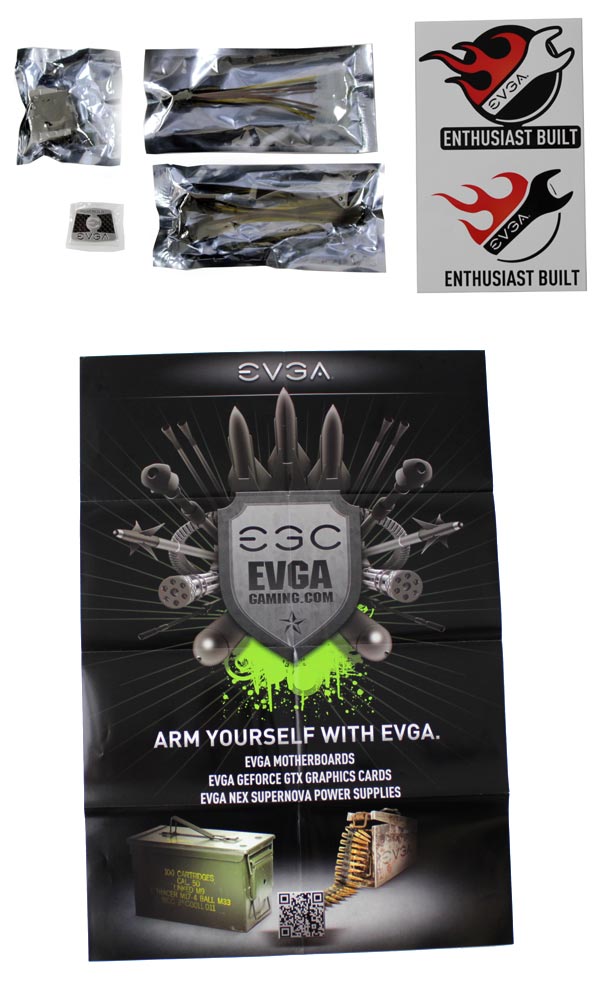
EVGA cools its GTX 670 Superclocked with a blower style fan. The cooler is based on the reference design, although the hood makes it look like a brand new design. In general , the GTX 670 SC is similar to the GTX 680 Signature card we tested here.
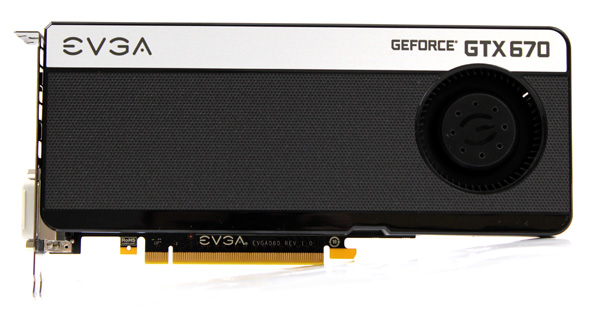

Things get interesting once you flip the GTX 670 over. The PCB ends where the power connectors are but partners are free to implement own designs. In this case, EVGA stuck to the reference design.
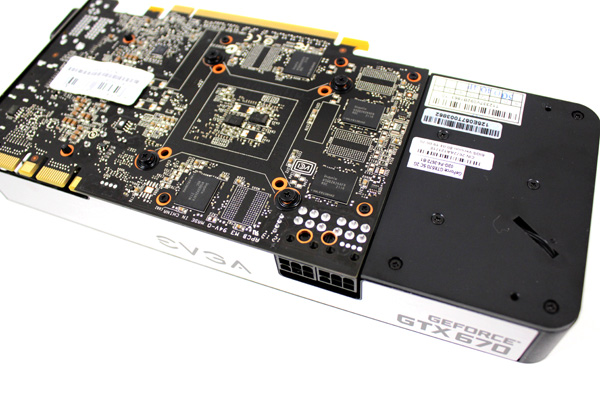
You don’t need to remove cooling in order to see memory modules, or at least half of them. As you can see, the memory chips are placed in a way where every next chip is on the opposite side of the PCB. EVGA’s GTX 670 SC has eight memory chips with 2GB of GDDR5 memory. The card packs eight memory chips totaling at 2GB of GDDR5 memory. Good news for Nvidia fans is that the company kept the identical memory system used on its GTX 680 card, meaning four 64-bit memory controllers (256-bit memory interface) and 2GB of GDDR5 memory. The memory runs at 1502MHz (6008MHz effectively), again just like the GTX 680.
EVGA’s GTX 670 Superclocked runs Hynix memory chips (model No: H5GQ2H24AFR-R0C). The chips are specified to run at 1500MHz (6000MHz GDDR5 effectively). GTX 670 Superclocked’s memory runs at 1552MHz (6208MHz effectively). We’ve seen this same memory on many AMD HD 7970 cards, although it ran significantly slower at 1375MHz. Note however that HD 7970 cards come with 3GB of memory.

The mesh finish on the Superclocked’s cooler looks quite attractive, but closer inspection reveals it’s only a finish on plastic.
Blower style fan pushes air through the cooler and forces it out. Dual fan coolers are usually the best ones but they tend to leave hot air in the case. Anyhow, you’ll have to have adequate cooling if you want to throw in a GTX 670.
The plastic shroud, which we took off on the picture below, acts as a tunnel for air, channeling it from the fan, across the heatsink and out the I/O panel exhausts.
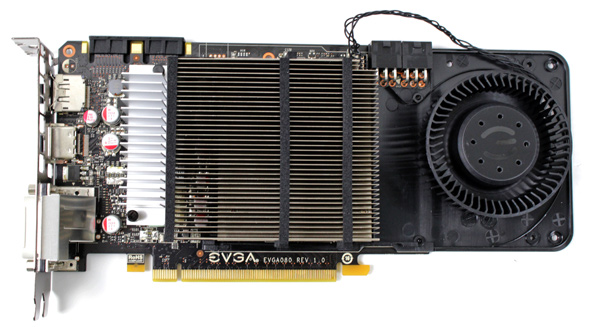
Although the GTX 670 is 24.1cm long, the PCB is only 17.2cm. Nvidia moved the power circuitry from its usual spot at the end of the card. This left empty space at the end of the PCB, so the company simply cut it off and saved on materials.
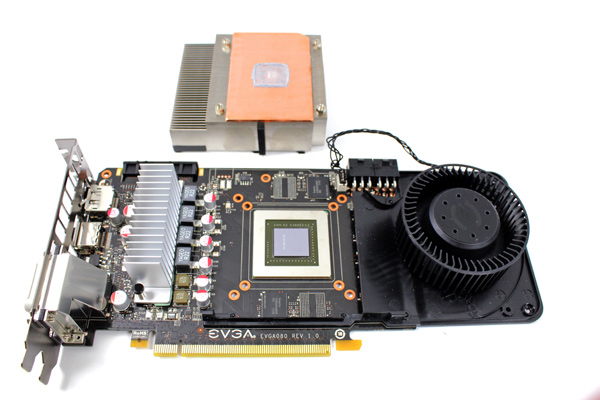
The memory on the PCB side isn’t cooled.
The heatsink is smaller but somewhat resembles the GTX 680’s heatsink (picture below).
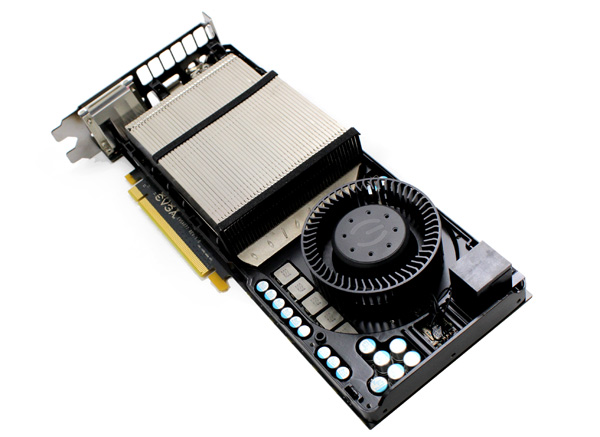
Reference GTX 670 cards draw power via two 6-pin power connectors, just like the factory overclocked EVGA GTX 670 Superclocked. The reference TDP stands at 170W, but you can expect EVGA’s GTX 670 Superclocked to slightly top that due to the overclock.

It would be nice if EVGA offered its Backplate for this card, since it does many things. Namely, it makes the card look sweeter, reinforces the PCB and can even passively cool the memory.
The following photo shows how Nvidia did the part where the PCB and cooler meet. The fan is on a separate piece of plastic that’s fixed to the PCB via four screws.

EVGA GTX 680 SC Signature comes with two dual-link DVI outs, but only one is analog VGA-out capable. EVGA made things easy by marking the VGA-capable out with “DVI-I”. The plastic caps are also a nice touch. The I/O panel holds a standard HDMI and standard DisplayPort. Nvidia made sure not to lag behind the competition so Kepler based cards can run up to four displays simultaneously.

The air exhausts are wider than on the reference card. This allows for easier air movement, which can decrease temperatures by up to 3°C in best case scenarios.
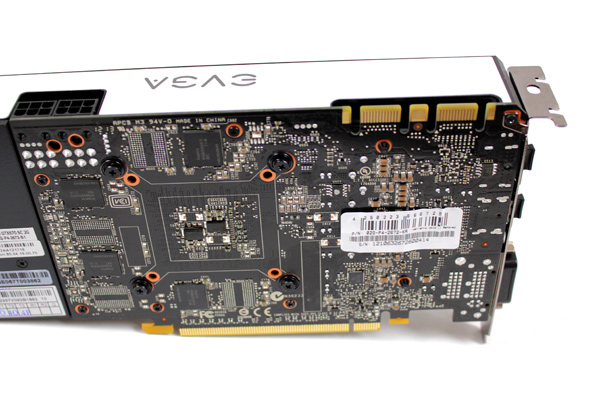
Motherboard: EVGA X79 FTW
CPU: Sandy Bridge-E Core i7 3820 (3.6GHz)
CPU Cooler: Thermalright HR-02 (Thermalright-Europa Distri www.PC-Cooling.de).
Memory: 8GB ADATA DDR3 1600 XPG Gaming series
Harddisk: OCZ Vertex 2 100 GB
Power Supply: CoolerMaster Silent Pro 1000W
Case: CoolerMaster Cosmos II Ultra Tower
Operating System: Win7 64-bit
Nvidia 301.34-desktop-win7-winvista-64bit-english-whql
amd_radeon_hd_7800_8.95.5_win7-64
12-3_vista_win7_64_dd_ccc.exe

3DMark11
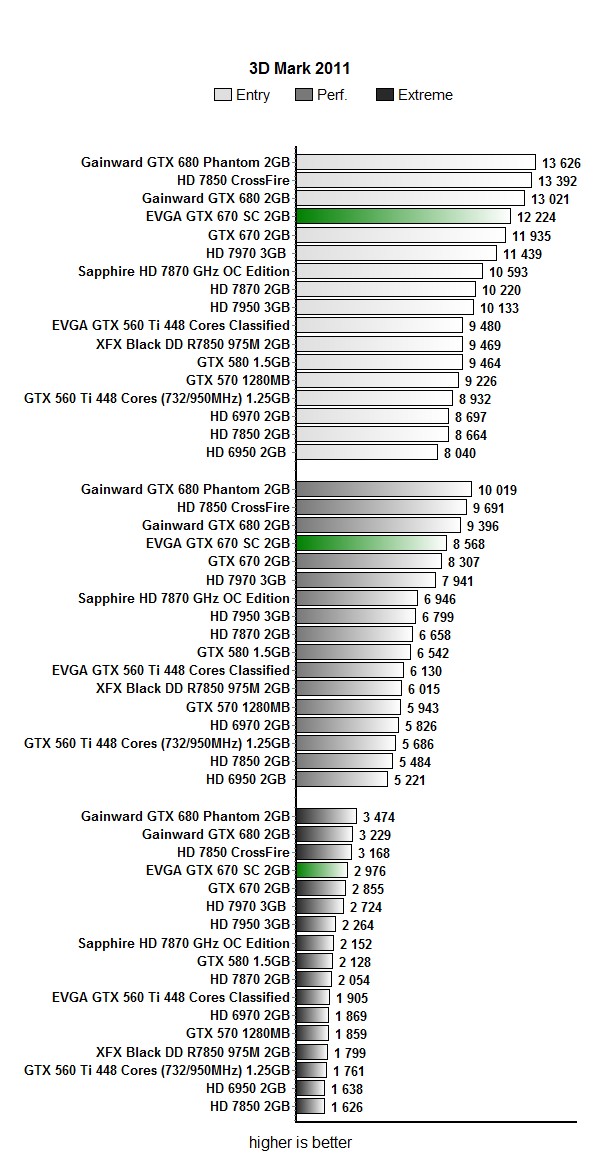
Crysis 2

Aliens vs Predator
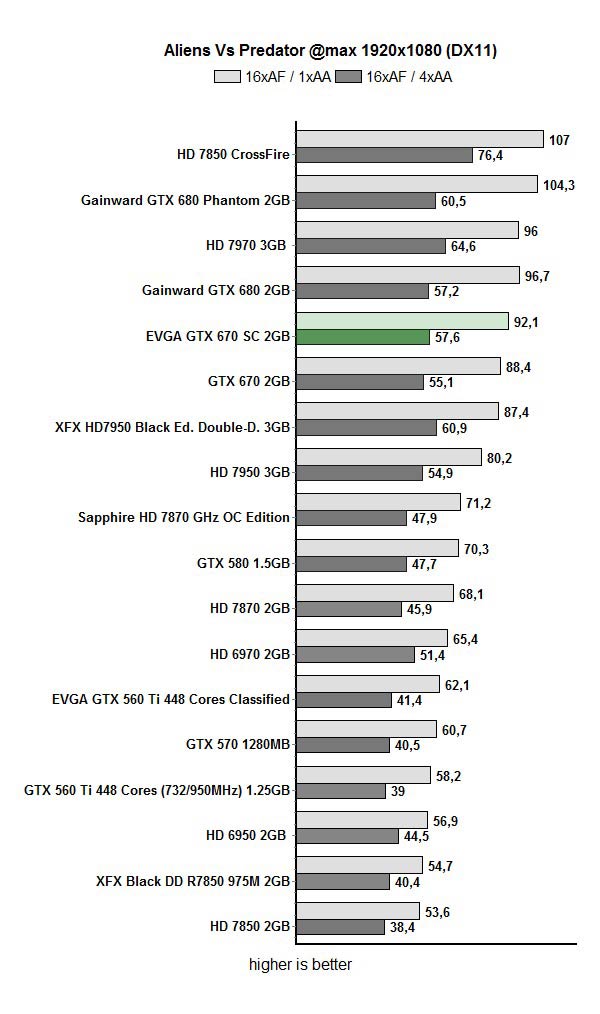
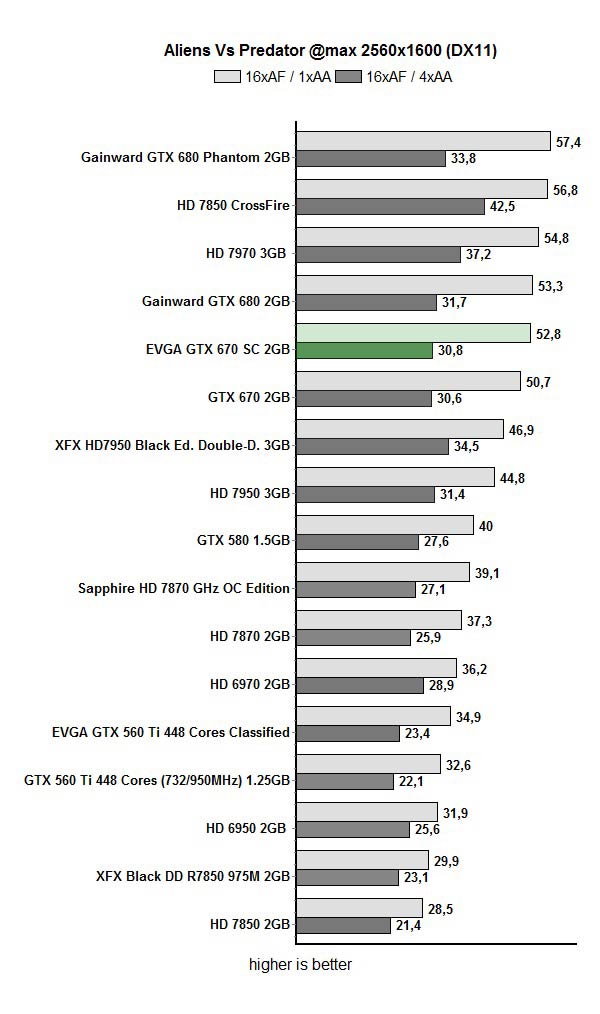
Metro 2033


Unigine Heaven
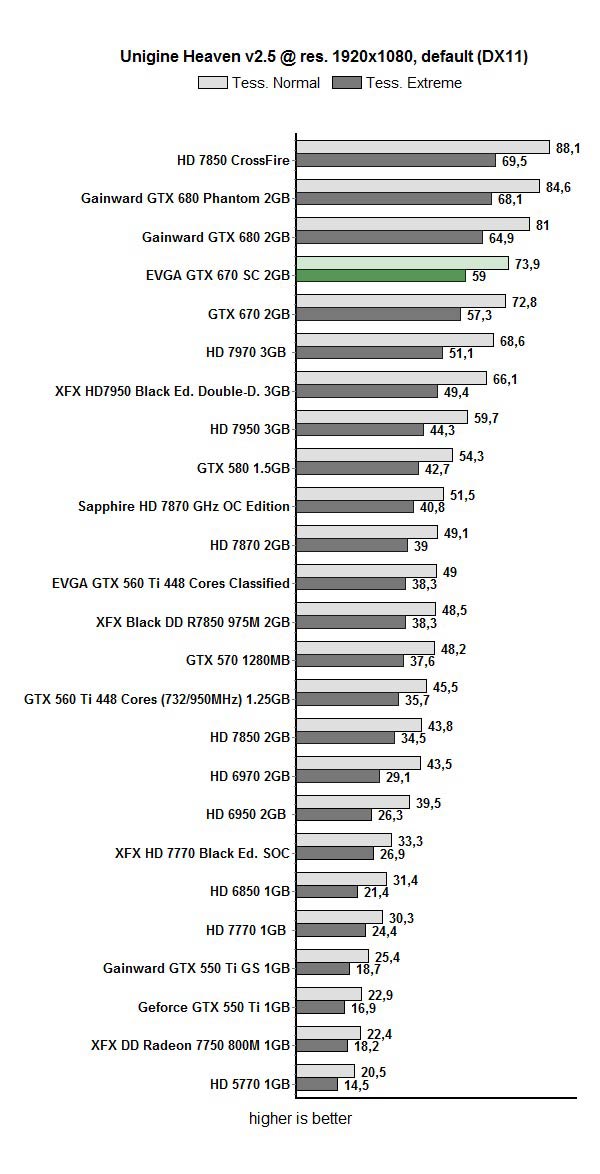
GPU Boost is an important factor in the entire GTX 600 series, since it controls how much and when to auto-overclock the GPU. Below you’ll find GPU clocks we got playing Metro 2033 at 2560x1600. Base clock is the guaranteed clock while Boost and all other clocks depend on whether the GPU is working too hard, whether thermals are fine and whether consumption is optimal. EVGA GTX 670 Superclocked’s Base clock is 967MHz, Boost is 1046MHz. As you can see, clocks went up to 1189MHz. GPU Boost is good because the chip was used to the max and users don’t have to mess with overclocking since the card is already doing it itself.

Frame rate target is a function Nvidia launched with its GTX 680 series. If your favorite game isn’t very demanding and your graphics card is capable of spewing out a super high frame rate, then you can limit it to 60fps or lower. In turn, this decreases GPU temperatures, noise and your electricity bill as well.
Powerful graphics cards consume a lot of power, especially when the GPU constantly runs at full throttle. In case of the GTX 670 Superclocked card, we managed to slash consumption by 9W in Aliens vs. Predator by limiting the frame rate at 60fps. The resolution in question was 1920x1080. As you can see, the graph shows that our card dropped below 60fps at one point, rendering the frame rate target inactive.

The graph we see on the picture below (right) shows the workload and consumption when frame rate target is off. On the left you see what happens when frame rate target is on. GPU was utilized to about 100% until we turned on the frame rate target option, which significantly decreased it. Additionally, consumption also went down. The values you see were measured while playing Aliens vs Predator at 1920x1080.

We used EVGA’s Precision v.3.0.2. and this tool allows setting frame rate target to any value from 25fps to 120fps. Note: you must restart the application for the setting to apply.
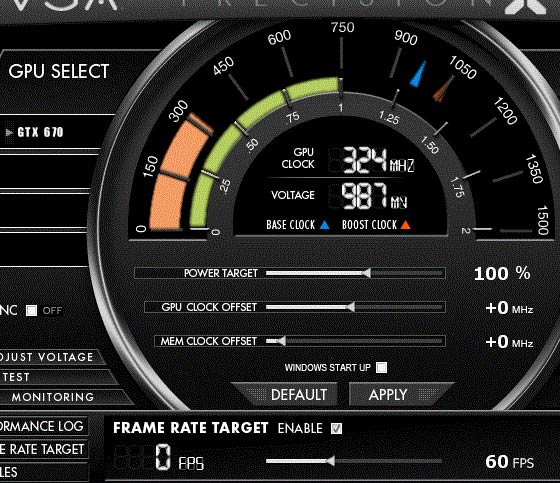
GPU Boost technology takes care of the card so overclocking is not as simple. Kepler GPU has two clocks – one being the Base clock, which is the guaranteed clock, while the other is Boost clock, average auto-overclocking clocks. Whenever there’s room to do so (depending on GPU workload, consumption and thermals), GPU Boost will auto-overclock. When we want to overclock the GPU, we increase the Base clock and hope that GPU Boost technology will “grant” our request. Unless we overdid it, GPU Boost will make sure to squeeze out more juice from the chip.
As the name suggests, EVGA’s GTX 670 Superclocked is a factory overclocked card. Its GPU runs at 967MHz, and the memory at 1552MHz.
With the launch of its GTX 670, EVGA made a new skin for its PrecisionX v.3.0.2. tool (picture below).

We had no trouble pushing the GPU by another 100MHz and the memory by 150MHz via PrecisionX tool. We moved the Power Target slider to 122 percent, the GPU Clock Offset to +100MHz, sped up the fan to 65 percent RPM (around 2670RPM) and increased the voltage from reference 988mV to 1050mV. The fan could be heard at 65 percent RPM, although it’s not too loud. When in AUTO mode, the fan was rarely audible and even then was quite unobtrusive. The fan is almost inaudible when the card is idle.

Maximum EVGA PrecisionX-allowed voltage is 1175mV. We didn’t have much time do dedicate to overclocking but we’ve noticed that after changing GPU Clock Offset by +120, upping the voltage had an adverse effect on stability. We believe that it’s down to the GPU Boost technology. Still, GPU Boost does its job quite well because it still auto-overclocked even after our additional 100MHz GPU overclock. So, we measured clocks all the way up to 1288MHz.

EVGA GTX 680 SC Signature uses reference cooling styled to suit EVGA’s image. The cooler itself is the reference one with wider air exhausts on the bracket.

The cooler is quite good when it comes to noise. When the card is idle, you’ll barely hear it. You’ll also hear it when the card gets hot, but nothing too loud and a job very well done. GPU temperatures were at about 80°C under load, which is comparable to the GTX 680’s thermals. Note however that the GTX 680 is noisier than EVGAs GTX 670 Superclocked.
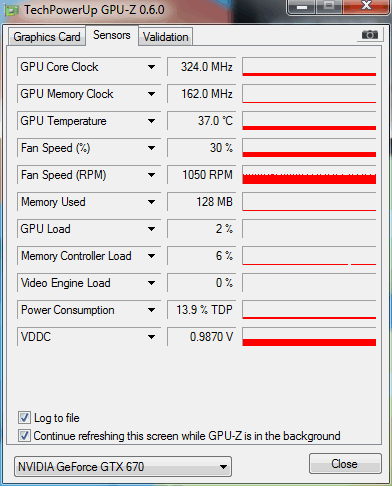

Although it ticks at higher clocks, EVGA’s GTX 670 Superclocked’s consumption isn’t as high when considering the performance.

EVGA was right on time for the GTX 670 launch with its Superclocked card, which comes overclocked to 967MHz and its memory at 1552MHz (6208MHz effectively). Note that the reference clocks are 915/1502MHz GPU/memory. Higher clocks of course mean better performance but overclocked or not – the GTX 670 is a great bang for the buck. Furthermore, the card allows for using up to four displays simultaneously.
Suggested pricing for the reference design is €329 EX VAT or $399 USD. In return, you get a graphics card that will support your 2560x1600 habit.
Compared to the GTX 570, you can expect about 40 percent better performance. The GTX 470 is 1.5-2 times slower than the GTX 670. It’s not looking rosy for AMD as the GTX 670 manages to challenge even the HD 7970 occasionally.
EVGA GTX 670 Superclocked is based on the reference design, with the exception of higher clocks and cooler makeup. The cooler is quiet in idle mode and quiet enough during gaming. You will hear it occasionally but it’s not too loud. We can say the same about the thermals as well.
We’ve seen that many partners are ready with their factory overclocked GTX 670 graphics cards and EVGA sure joined in on the fun. The company’s offer currently lists the following GTX 670s:
EVGA GeForce GTX 670 2GB: $399.99
EVGA GeForce GTX 670 2GB Superclocked: $419.99
EVGA GeForce GTX 670 4GB: $469.99
EVGA GeForce GTX 670 4GB Superclocked: $489.99
As you can see, our today’s card is priced about $20 higher than the reference version. The added price goes on the factory overclock, makeover and the wide exhaust bracket that improves cooling. The card is backed by a 3 year Limited warranty with an option to pay for an extension to 5 or 10 years. All in all, the $20 price difference is a small price to pay for a card that promises to become many a gamer’s ally.





